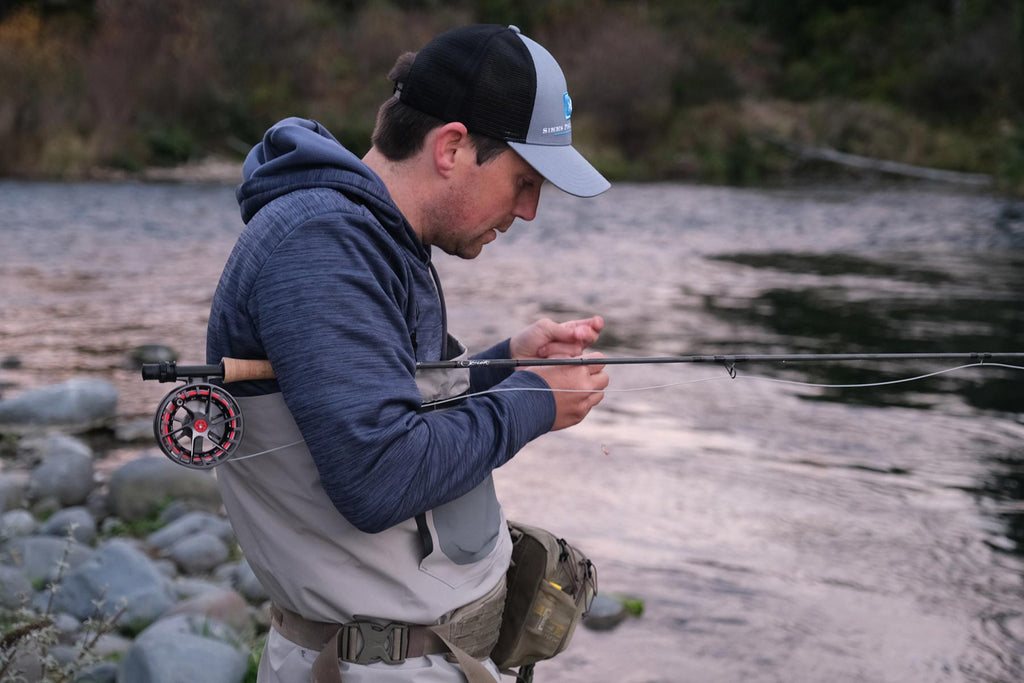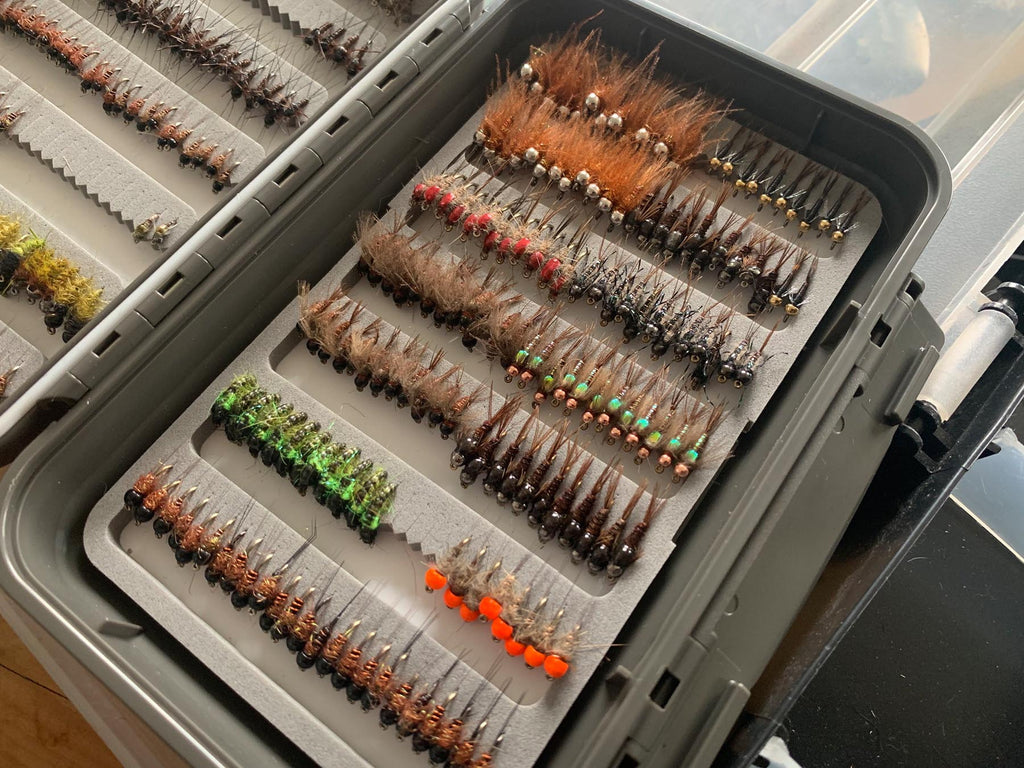Better Winter Nymphing Presentations
Where summertime is all about long, fine leaders, stealth and delicacy, winter nymphing is about getting things done with flies and scenarios that often present problems.
The objective of deep, winter nymphing is to get your flies down to the bottom. The sooner, and longer they drift in the zone the more time winter trout have to locate, and eat them. The key factors in achieving quick depth are removing, or reducing resistance to the fly, and the weight and profile of the flies themselves.

LEVEL WINTER NYMPHING LEADERS
TRY A SECTION OF TAPERED LEADER
While level leaders are a great tool for those who can handle them, the positioning of a visible indicator can rob your cast of energy and fail to turn your flies over on longer leaders.
One option is to clip your indicator directly to the loop on your fly line, however, the transition between your thicker fly line and level 3 or 4x can create other issues.
To smooth out your turnover, try a short, powerful butt section to your indicator leading to a tippet ring, then several feet or more of level fluorocarbon.
The short, 3’ butt section will continue energy to your indicator and help smooth out your cast somewhat. Ensure a long, smooth loading move, laser straight tracking and a late, smooth rotation to turn your rig over.
REDUCE TIPPET DIAMETER WHERE POSSIBLE
Reducing the diameter of our leaders to further reduce the pull of the currents Is the common practice in getting our flies deeper. Modern, fine-diameter tippet materials present less mass to the water and are pulled through the surface and water column more effortlessly by our flies.
Keeping this in mind, longer, level tippet sections offer benefits here over our more traditional tapered leaders, which present more mass as the flies sink, and the thicker mid and butt sections will slow your fly's descent.
Remember, tapers are designed to transfer energy and unfurl your cast. With the inertia and momentum of heavier flies, they will easily turn over a longer, level leader.
GIVE EURO A GO
This is where recently popular euro nymph techniques can come into their own. Euro nymphing rods are designed to better protect finer tippets and, with your leader suspended beneath the rod tip, your flies get to depth with vastly reduced influences from both the surface currents and water column.
Sometimes however you can only afford a short drift, and so you must add weight…

WINTER NYMPHING PRESENTATIONS
Heavy flies are often a chore to cast and to present accurately for many. As your cast turns over, the inertia of a pair of heavy flies continues in the direction of the cast, often pulling up tight, bouncing back or kicking in the final stages, introducing slack line to your cast. Here are a few tips on how we can counter this.
TRY AN ELLIPTICAL CAST
Consider an elliptical, or Belgian cast when dealing with streamers and heavier nymphs. As seen in our Lockdown Lessons video below, the elliptical, or constant tension cast is an easy way to remove the kick from heavier flies and is simply performed with a horizontal-oriented backcast, pulled through into an overhead forward stroke.
MENDING IS EVERYTHING
Employing mends, and the aforementioned longer, finer diameter level tippet will allow you to often get lighter flies deeper, allowing more control and accuracy of your presentation, and avoid somewhat the need for heavier flies.
We employ mends either aerially, or after the line lands, to reduce the tension on our fly, allowing it to move more freely through the water column and sink without inhibition of tension from the fly line.
The tuck cast, or overpowered forward cast is a popular presentation with nymph anglers allowing the fly to land first, followed by a pile of slack leader. Simply aim your vertically oriented loop a tad higher, and either overpower or pull back in the final stages of your delivery immediately following the stop. If pulling backwards, imagine ‘bouncing’ your hand.
However, for precision, accuracy and control I’m a huge fan of the Reach Mend, as demonstrated below.
You can choose how much slack you wish to add to your presentation with the added bonus of your flies landing ready to fish. Once your flies land and begin sinking, they are not lifted again by some gaudy, overcooked mend, losing the precious depth they have gained in the initial stages of their drift.
USE HEAVY FLIES
Weighting the fly is the most common method to attain depth for winter nymphing. Tungsten beads, lead underbodies and wired bodies are all options; employed singularly or in combinations to create a heavier fly. Reducing buggy materials that can trap air and hold up in the water column is another way to create a quicker sinker, or employ epoxied bodies for even less resistance and a super slick sink.
The Bomb Squad, Simon's Uglies and Iron Maidens are deadly examples of employing weight into super successful flies.
Remember the finer your tippet, the quicker your fly will sink. Even the heaviest bomb won't sink too fast if attached to something the diameter of a garden hose.

ADD WEIGHT TO YOUR LEADER
Weighting the leader is another common practice for adding weight to your rig. Loon Deep Soft Weight is a non-toxic tungsten putty that you can easily adjust according to the amount you roll onto your leader. Simply pluck out the desired amount, roll it between your hands to soften it up and apply it to your leader in a small ball or oblong. Make sure you drop it into the river before making your cast to harden and set the putty.
Loon Black Drops are a reusable, non-toxic alternative to traditional lead split shot and come in three weights: .8g, .4g and 1.2g.
Add as many as needed to get down fast. A handy tip to protect finer tippet is to split your tippet six inches or so above your top fly and reattach it using a blood knot leaving the downward tag end long, similar to the drop shot method. If you have tied an overhand knot in this tag end before tying your blood knot then you have a short dropper independent of your main leader to which you can squeeze on your shot, without risking the integrity of your leader.
You may also wish to reattach your tippet via a tippet ring which gives you the option of using lighter breaking strain nylon to create your dropper. The benefit of this is if your shot snags up, chances are this will break away before your flies do. Remember the overhand knot at the end of your shot dropper - this is what prevents your shot from slipping off.
The final benefit of employing this shot rig is that you can use the shot for weight, and choose lighter, or even unweighted flies for more natural movement. This is especially effective in low flows, on clear bright days, or on more pressured fish.
There is plenty more winter nymphing ahead of us so get out there and get down to where the fish are.
ABOUT THE AUTHOR:
Chris Dore is a battle tested fly fishing guide with over 15 years of professional guiding experience, battling the demanding, ever changing conditions that our New Zealand rivers throw at us.
In 2006 Chris became one of the first New Zealanders to successfully pass the internationally recognised Federation of Fly Fishers Certified Casting Instructors examination and has since taught many thousands of anglers to up their skillset.
For more in person and on river fly fishing advice and upskilling why not book Chris for a day or three?
